In this article, discover how to effectively manage your business finances within the Pabau platform, covering key features like Discounts, Invoice Templates, Quote Templates, and more.
Table of Contents:
1. How to Set Up Invoice Templates2. How to Create and Manage Quotes
3. How to Manage Discounts
4. How to Enable Promo Codes in Your Online Bookings
How to Set Up Invoice Templates
Creating customized invoice templates that reflect your company's branding and include essential information is crucial. Follow these steps to set up your invoice templates in Pabau:
Step 1: Access Invoice Templates
Start by logging into your Pabau account. Navigate to the Setup section in the left sidebar menu, then select "Invoice Templates" under Financials. Alternatively, use the search bar in the top right corner of the Setup section.
Step 2: Create or Edit Templates
There is at least one default template, but you can create more by clicking on "New Invoice Template" in the top right corner.
To edit an existing template, click on the one you want to modify. All templates share the same components, whether you're creating a new one or editing an existing template.
Template Overview: In the center of the screen, you'll see a preview of the invoice. Any changes you make will be reflected in real-time. The main components are Appearance, Payment Info, and Header.
Appearance Tab:-
- Choose the template type (Invoice, Receipt, or Statement).
- Set the template as default if needed.
- Upload your logo and adjust its size and position.
- Customize margins and text color.
- Choose the format for displaying client names.
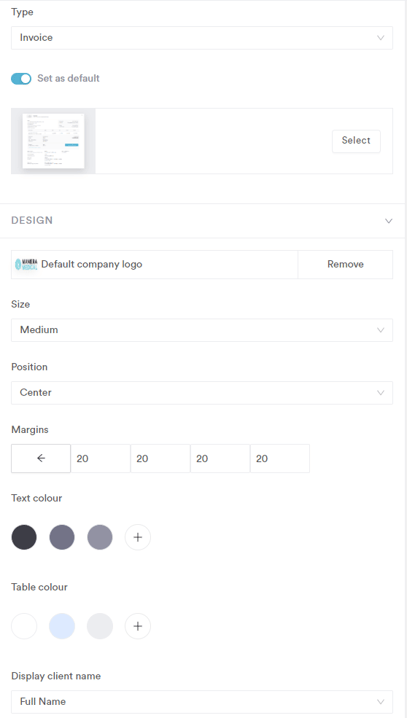
Payment Info Tab: This tab has three parts: Body, Totals, and Payment.
- Body Tab:
- Select fields to be displayed on the invoice.
- Rearrange and rename elements as needed.
- In the "Available" tab, you can see all of the elements that are not currently displayed on the invoice. To add some of the available elements, tick the box before the element you want to use.
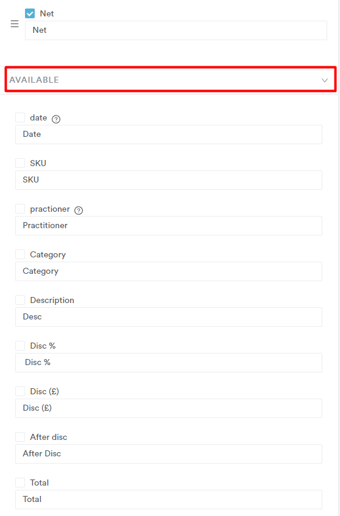
- Totals Tab:
- Choose which elements related to the amount paid will be displayed.
- Payment Tab:
- Decide whether to display bank details or add a button for online payments via Stripe.
- Fill out bank details if displayed.
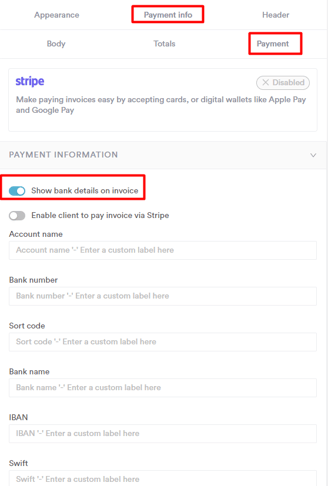
Header Tab:
- Company: Set a name for the invoice and add your business name, address, and contact information.
- Customer: Choose client-related information to display, such as the payment method used, appointment date, authorization code, or customer ID.
- Employee: Decide whether to display the name of the employee who raised the invoice.
- Messages: Add additional messages to display at the bottom of the invoice.
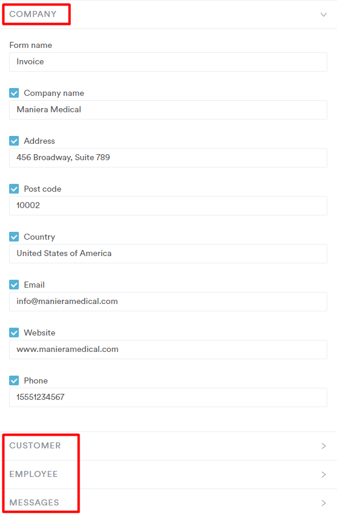
Step 3: Save Changes
To save the changes made to the invoice template, click on the "Save" button in the top right corner.
By following these steps, you can create or customize invoice templates to suit your business needs and maintain a professional appearance when interacting with clients.
NOTE: You can also learn about this topic by watching a lesson on Pabau Academy.
How to Create and Manage Quotes
Effectively managing quotes is crucial for your business, and Pabau offers a comprehensive system to streamline the process. This guide provides detailed steps to enable, create, and manage quotes within the Pabau platform.
Step 1: Enable Quotes Feature
Log in to your Pabau account and in the left menu, go to Setup. Next, select "Business Details" under the "Business" section.
Choose the "Features" subtab and scroll to the bottom, then enable the "Quotes" feature.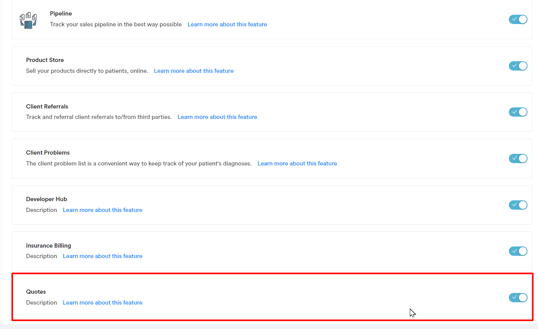
NOTE: You can also learn about this topic by watching a lesson on Pabau Academy.
Step 2: Create Quote Templates
After enabling quotes, go to Setup and navigate to the "Financials" section. Click on "Quote Templates".
The existing quote templates will be visible in this section, with the option to order the templates, to see the template name, created, and date modified, as well as a three-dot icon, through which we can edit, clone, or delete the template.

Click on the "Create Template" button on the top right to create a template by customizing fields and appearance.
Customize the template appearance using the "Appearance" and "Components" sections.
Within the "Appearance" tab, you can add a name for the quote template, set the template as default, upload your logo, and adjust its size and position.
Additionally, you can customize margins and text color.
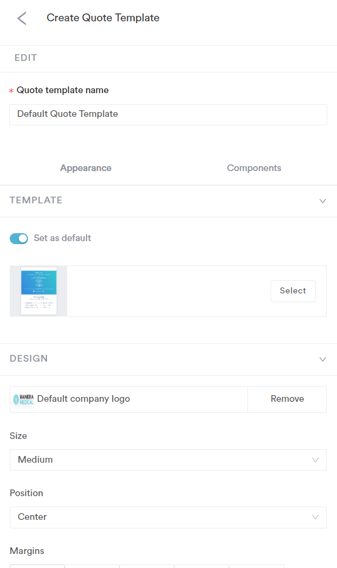
Within the "Components" tab, you can configure various aspects of the quote, including:
- Quote Name: Designate a title for the quote, prominently displayed at its top.
- Body Content: Customize the text within the quote's body, utilizing merge tags for automatic integration of business and client information.
- Line Items Table: Tailor the information displayed for products and services included in the quote.
- Payment Terms: Define your payment terms, and if desired, include "Terms and Conditions" in the last component, which will introduce a dedicated button in this field.
- E-Signature and Print Signature: Incorporate fields for either an electronic or printed signature.
- Download Button: Modify the text on the Download button for a personalized touch.
- Footer Message: Append a custom message to the footer for additional context.
- Fees & Distribution: Adjust the name of the Fees & Distribution section as needed.
- Terms & Conditions: Input your specific Terms and Conditions to ensure clarity and transparency.
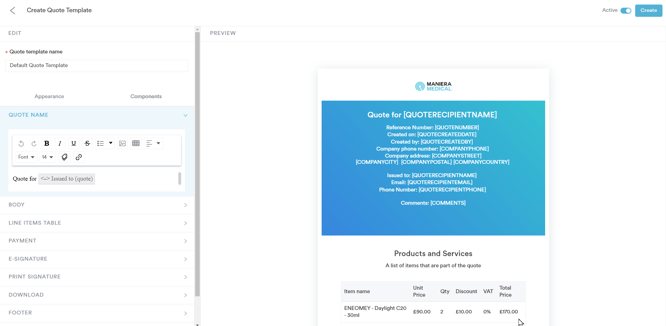
Preview the design on the right and click on "Create" to save the template.
NOTE: If no custom template is created, the system will generate a default template with default settings.
Step 3: Setup Fee Distribution
In Setup, go to the "Financials" section, then select "Quote Fee Distribution".
The currently created fee distributions will be visible in this section, with the categories on the left and the fees in the middle. Create a category first using the button on the left. Once the category is created and selected, we can create fees.
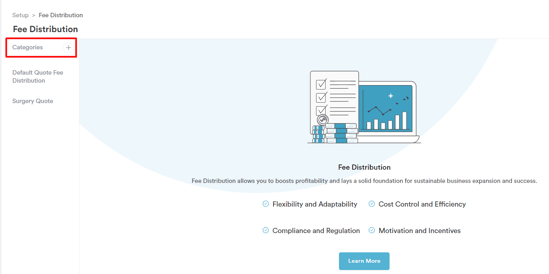
Click "New Fee" in the top right corner to add a fee. Write the fee name and percentage. The total percentage within the category of all of the fees should be 100%.

The fee section has several options: to order the templates, to see the name of the fee, the fee percentage, the date created, the date updated, and items, as well as the 3 dots, through which we can add fee items, edit, or delete the fee.
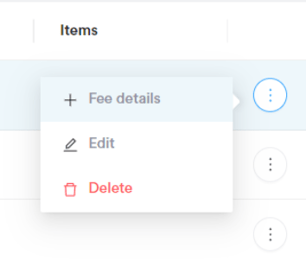
Click on the "Fee details" button on the right side, to create them within the system.
The fee details section shows the products, tax, and fee percentage section. The total percentage of the fee items should be 100%.
Step 4: Create a Quote
Navigate to "Money" in the left side-bar menu, then click on "Quote". Here, you can view existing quotes or click "Create Quote".
Select the client and appointment on the left.
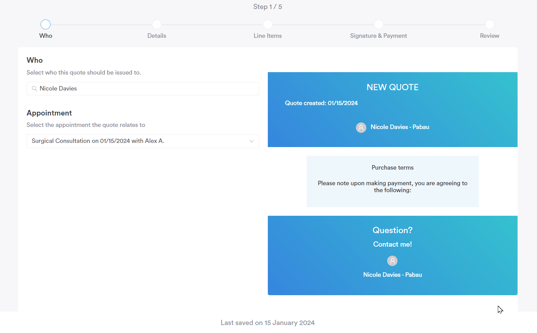
Complete the quote template by moving to the next steps by clicking on "Next" in the top right corner.
Under "Details", select the quote template from the ones available, the quote name, and the quote owner. The location would be automatically related to the appointment and the expiration date.
The "comments to buyer" and "purchase terms" fields can also be included in the template.
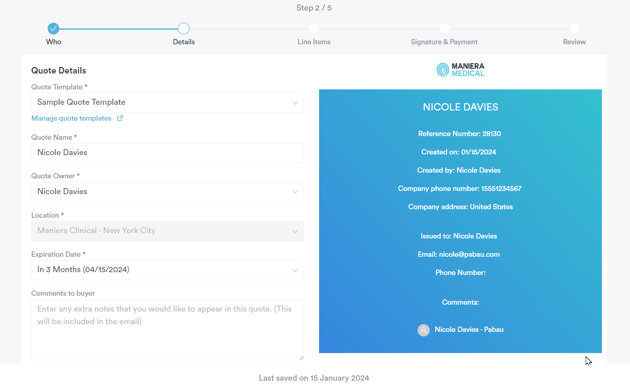
In the "Line Items" step, select the "Add Line Item" button on the right side, and choose the items from the services, products, or packages section.
By clicking on the "Manage fee distribution", you can select one of your quote fee distributions created in "Quote Fee Distribution".
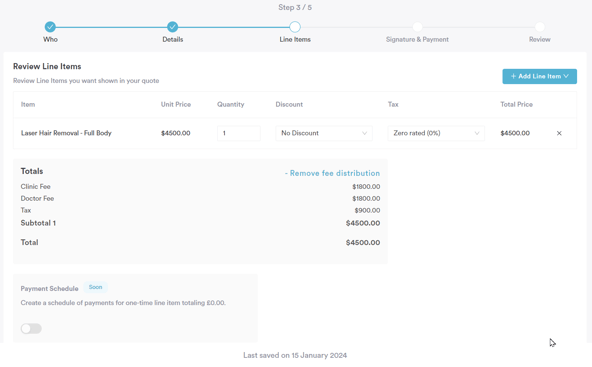
Step 5: Set Signature and Payment Option
Select whether to include a signature and payment option within the quote.
The last step after "Signature & Payment" is the "Review" step, from which we can review the quote before sending it over to the client.
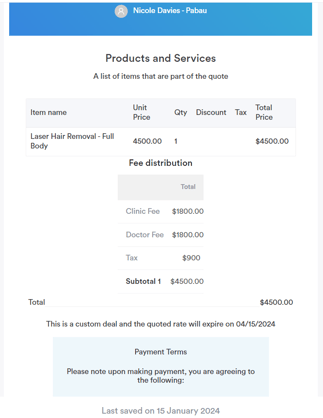
Click on the "Create" button to create the quote within your Pabau account.
Step 6: Share Quote with Client
Once the quote is created, a pop-up will appear with the link of the quote, which we can copy and send to the client or click on the "Write Email With Quote" button to write an email to the client and send the quote to them.
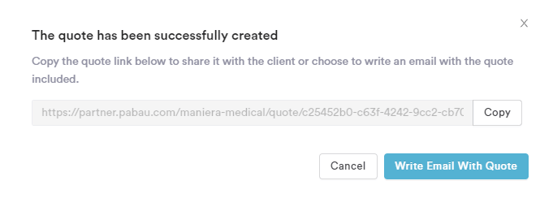
After closing this window or proceeding to send the quote to the client, the system will save the quote under the "Money" section, specifically within the "Quotes" category, with the status indicated as "Pending Signature."
Step 7: Manage Quotes
Once saved, the quote will appear in the "Quotes" section.
Next to the name of the client, the "Action" section will appear.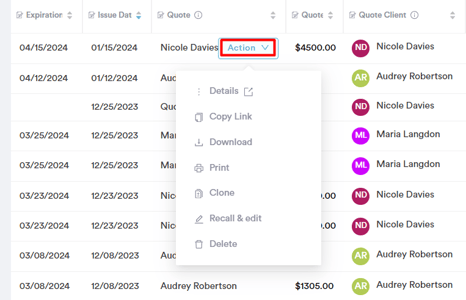
Under the action section, we can manage the quote, from which we can access the details, copy the link of the quote, and download, print, clone, edit, or delete the quote from the system.
Step 8: View Quotes in the Client Card
We can also view the quote in the client card by searching for a client in the search bar.
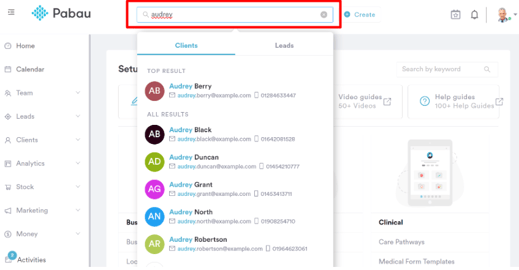
Type in the name of the client and select them to access the client card. Then, proceed to the "Financials" sub-tab.
The second tab is the "Quotes" sub-tab under the Financials. From there, we can see all the quotes related to the client, including the quote number, status, and sharing options.
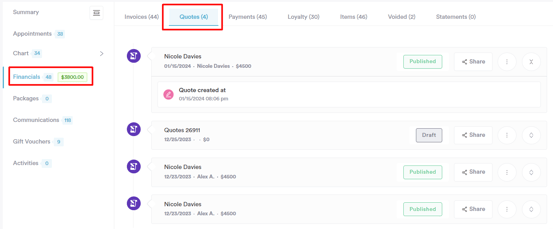
Additionally, three dots on the far right provide the same functionalities as the "Action" button in "Quotes".
By following these steps, you can efficiently enable, create, and manage quotes within the Pabau platform for a streamlined business process.
How to Manage Discounts
Effectively manage and create discounts in Pabau by following these step-by-step instructions. Customize default discounts and create new ones to enhance your financial processes.
Step 1: Access Discounts
Start by logging into your Pabau account. Navigate to the Setup menu in the left sidebar, then select "Discounts" under Financials. Alternatively, use the search bar in the top right corner of the Setup section to search for Discounts.
Step 2: View and Customize Default Discounts
In the Discounts section, there are two default discounts.
You can customize the default discounts and create new ones by clicking on them and modifying the name, discount type, value, and active status.
Step 3: Create a New Discount
To create a new discount, click on "Create Discount" in the top right corner of the Discounts feature.
Select the discount type, choosing between amount or percentage.
Step 4: Add Discount Details
Next, enter the name of the discount. Specify the percentage or amount of the discount.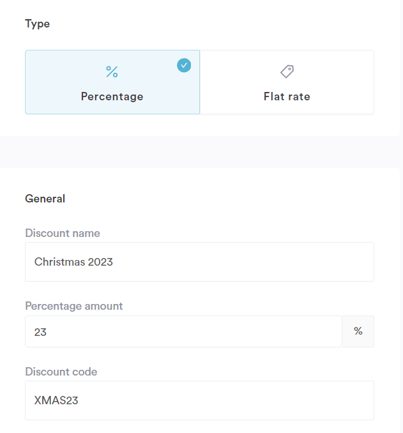
Optionally, you can include a discount code. This code can be shared with your clients as a promo code for use when paying for their appointments, whether it's in-clinic or online.
Click on "Rules" on the top right to define specific criteria for the discount.
Specify if the discount is related to particular services, locations, or staff, or if it applies universally.
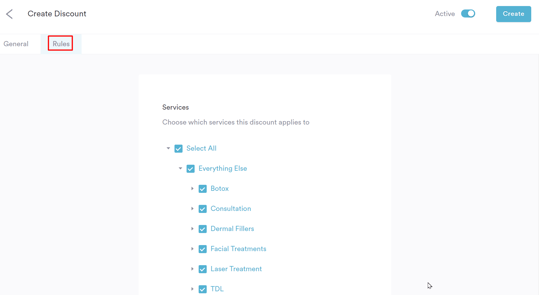
Step 6: Activate and Save
Once customization is complete, activate the discount using the "Active" button on the top right. Save the discount to add it to the system.
Step 7: Utilize Discounts in POS
The created discounts are now available for use in the Point of Sale. To use a discount in the Point of Sale, click on the name of the service or product you wish to apply the discount to and select the discount in the "Discount" field.
Discounts will be visible in the Client Card, reports, and other relevant sections.
By following these steps, you can seamlessly manage discounts in Pabau, ensuring flexibility and accuracy in your financial transactions.
How to Enable Promo Codes in Your Online Bookings
Promo codes are an effective tool for businesses to increase customer loyalty and boost revenue. Offering discounts through promo codes not only attracts new clients but also retains existing ones. Pabau provides a straightforward process to enable promo codes in your online bookings. Here's a step-by-step guide:
Step 1: Navigate to Discounts
Start by logging into your Pabau account. Navigate to the Setup menu in the left sidebar, then select "Discounts" under Financials. Alternatively, use the search bar in the top right corner of the Setup section to search for Discounts.
Step 2: Create or Edit a Discount
In the Discounts feature, create a new discount or edit an existing one.
Ensure that the discount includes a "Discount Code," which can be set up in the "General" tab.
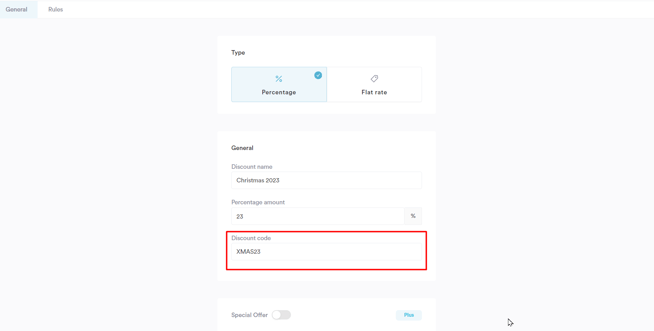
Step 3: Configure Online Booking Settings
Go back to Setup and click on "Online Booking" under Services, then select "Customize" on the right.
Step 4: Enable Promo Codes
In the Online Booking settings, access the "Your Booking Details" tab.
Check the "Allow promo codes" option and save the changes by clicking on "Save changes" in the top right corner.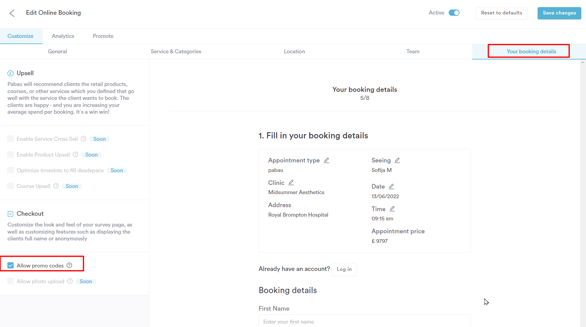
Enabling this option will introduce a field in the last step of the online booking process, allowing clients to enter the provided promo code. This code will automatically reduce the total price of their appointment.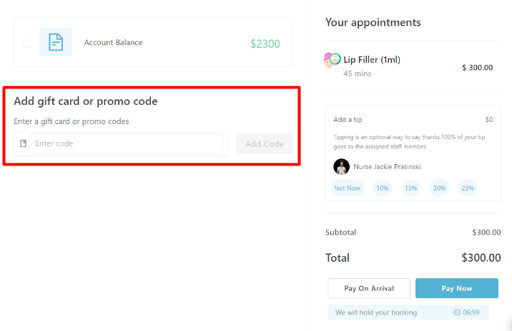
In addition to discount codes, clients can also use gift voucher codes as promo codes. To learn how to create gift vouchers, read this article.
NOTE: This option is only accessible when you have integrated Stripe with your Pabau account. To integrate Stripe, follow the steps provided in this article.
Step 5: Share Promo Codes
One effective way to share promo codes with clients is through email or SMS newsletter campaigns.
Create a marketing campaign to distribute promo codes to your clients, encouraging them to use these codes when booking appointments online.
By following these steps, you can seamlessly integrate promo codes into your online bookings, providing a valuable incentive for clients and contributing to the overall success of your business.
For more guides, refer to related articles below, select additional guides, or use the search bar at the top of the page. These guides will help you get the most out of your Pabau account.
Additionally, to help you fully utilize and understand your Pabau account, we recommend exploring additional guides and resources offered at the Pabau Academy. It offers in-depth video tutorials and lessons, offering a holistic learning experience that can equip you with the essential skills for achieving success with Pabau.
